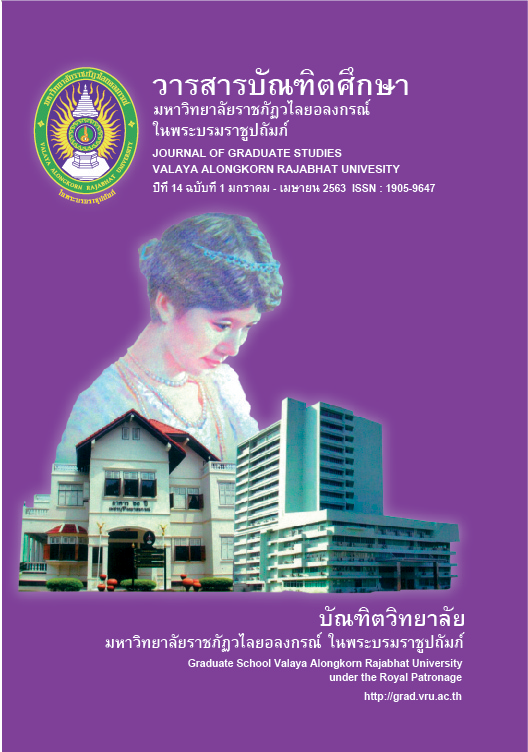EFFECTS OF RISK MANAGEMENT EFFECTIVENESS ON ORGANIZATION SURVIVAL OF TOURISM BUSINESSES IN THAILAND
Main Article Content
Abstract
The research was conducted a study of risk management effectiveness, organizational survival and effects of risk management effectiveness on organizational survival of tourism businesses in Thailand. This research employed a questionnaire as an instrument for collecting data from 351 of tourism businesses executives in Thailand by using stratified random sampling method. The statistics used for analyzing the collected data were mean, standard deviation and multiple regression analysis.
The findings indicated that the tourism businesses executives agreed with the risk management effectiveness as a whole at high level. In each of the following aspects were at high level: achieving goals and objectives aspect, decreasing chances of operational loss aspect, increasing working efficiency aspect and helping internal planning aspect and the aspects at a medium level: building stability and fluctuate revenue reduction aspect and solving problems in timelines aspect. The opinions on the organizational survival as a whole. In each of the following aspects were also at high level: profitability aspect, competitive advantage aspect and productivity aspect, and the analysis of the effects, the following were found that: achieving goals and objectives, decreasing chances of operational loss and increasing working efficiency had positive effects on the organizational survival as a whole of profitability competitive advantage and productivity. In conclusion, the risk management effectiveness has positively effects on the overall of organizational survival. Thus, it should be aware that risk management in the aspect of achieving goals and objectives, decreasing chances of operational loss and increasing working efficiency.
Article Details
บทความทุกเรื่องได้รับการตรวจความถูกต้องทางวิชาการโดยผู้ทรงคุณวุฒิ ทรรศนะและข้อคิดเห็นในบทความวารสารบัณฑิตศึกษา มหาวิทยาลัยราชภัฏวไลยอลงกรณ์ ในพระบรมราชูปถัมภ์ มิใช่เป็นทรรศนะและความคิดของผู้จัดทำจึงมิใช่ความรับผิดชอบของบัณฑิตวิทยาลัย มหาวิทยาลัยราชภัฏวไลยอลงกรณ์ ในพระบรมราชูปถัมภ์ กองบรรณาธิการไม่สงวนสิทธิ์การคัดลอก แต่ให้อ้างอิงแหล่งที่มา
References
Alijarde, M. I. (1997). The Usefulness of Financial Reporting in Spanish Local Governments. Financial Accountability and Management, 13(1), 17 – 34.
Allegrini, M. and D’Onza, G. (2003). Internal Auditing and Risk Assessment in Large Ltalian Companies: an Empirical Survey. International Journal of Auditing, 7(3), 191-208.
Athayaphan, P. (2007). phonkrathop khō̜ng prasitthiphāp kānbō̜rihān khwāmsīang thī mī tō̜ phonlakā rō̜dam nœ̄n ngān khō̜ng thurakit SMEs nai khēt Krung Thēp Mahā Nakhō̜n [The impact of risk management efficiency on the performance of SMEs in Bangkok]. Master’s thesis. Mahasarakham University.
Department of Trade Negotiations, Ministry of Commerce. (2013). samākhom ʻutsāhakam ʻāhān læ khrư̄angdư̄m [Food and Beverage Industry Association]. Retrieved from http://www.boe.ca.gov/transpubs/pdf/pub22-t.pdf.
Klomp, L. and Leeuwen, G. V. (2001). Linking Innovation and Firm Performance: A New Approach. Journal of the Economics of Business, 8(3), 343 – 364.
Laksana, S. (2000). kānphatthanā prasitthiphāp nai kānthamngān [Work efficiency development]. Bangkok: Faculty of Management Science, Suan Sunandha Rajabhat Institute.
Lovett, H. T. (2002). The Effect of Violating the Assumption of Equal Item Means in Estimation the Livingstone Coefficient. Education and Psychological Measurement, 38(1978), 239-251.
Muehlbach, S. D. (2008). Risk Management Content analysis: Understanding the Relationship with Continuing Education Planning. Dissertation Abstracts International, 69(6).
Nunnally, J. C. (1978). Psychometric Theory. New York: McGraw – Hill.
Pearce, J. A. and Robinson, R. B. (2005). Formulation, Implementation, and Control of Competitive Strategy. 9th ed. Singapore: McGraw-Hill.
Phanthudm, N., et al. (2011). nǣothāng kān khūapkhum phāinai thī dī [Good internal control guidelines]. Bangkok: Amarin Printing & Publishing Public Company Limited.
Rannan, S. (2007). kānbō̜rihān khwāmsīang khō̜ng Thanākhān ʻŌ̜msin nai khēt phāk tawanʻō̜k chīang nư̄a [Risk management of the Government Savings Bank in the northeastern region]. Master’s thesis Mahasarakham University.
Saakhaakon, C., et al. (2005). kān khūapkhum phāinai læ kāntrūatsō̜p phāinai [Internal control and internal audit]. Bangkok: T. P. N. PRESS Limited.
Saartchom, N. (2007). kānbō̜rihān khwāmsīang ʻongkō̜n [Enterprise risk management]. Bangkok: Than Printing Company Limited.
Sisaart, B. (2002). kānwičhai bư̄angton [Basic research]. 7th ed. Bangkok: Suweeriyasan Company Limited.
Sisaart, B. (2011). kānwičhai bư̄angton [Basic research]. 9th ed. Bangkok: Suweeriyasan Company Limited.
Stock Exchange of Thailand. (2004). nǣothāng kānbō̜rihān khwāmsīang [Risk management guidelines]. Retrieved from http://www.set.or.th/th/regulations/cg/files/2004/RiskManagementHandbookThai_Final.pdf.
Suwansan, M. (2009). nǣothāng kānbō̜rihān khwāmsīang thūa thang ʻongkō̜n [Guidelines for risk management throughout the organization]. Retrieved from http://www.itgthailand.com.
The Institute of Internal Auditors of Thailand. (2008). botkhatyō̜ samrap phūbō̜rihān krō̜p khrōngsāng kānbō̜rihān khwāmsīang chœ̄ng būranākān [Abstract for Executives - Integrated Risk Management Framework]. Bangkok: SE-EDUCATION Public Company Limited.
Tourism Authority of Thailand. (2014). khō̜mūn phūbō̜rihān thurakit nā thīeo nai prathēt Thai [Information of tour business executives in Thailand]. Retrieved from http://thai.tourismthailand.org.


